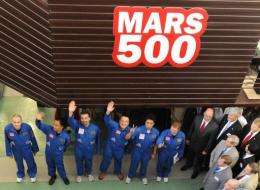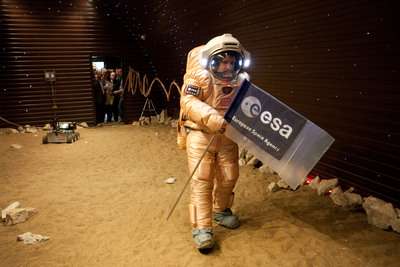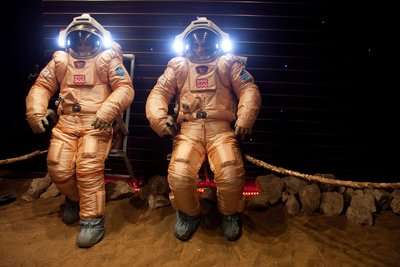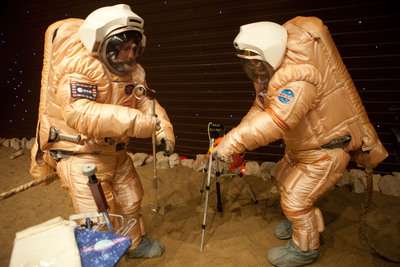Members of the Mars 500 crew wave before being locked into the isolation facility in Moscow in June 2010. Two volunteers from Italy and Russia will step onto a sandy mock-up of the Martian surface at around 1:00 pm (1000 GMT) after a gruelling eight-month journey -- all without ever leaving a Moscow research centre.
Two volunteers cut off from the rest world for eight months stepped out on a mock-up of Mars on Monday, reaching the dramatic half-way point of their experimental "voyage" to the Red Planet.
Outfitted in heavy white space suits and clunky boots, the Russian and Italian volunteers left their capsule and took their first careful steps on the red sands of Mars -- all without ever leaving a Moscow research centre.
Grainy footage of their space walk, replete with crackly sound interference reminiscent of trips to the Moon, was watched live by top Russian and European space officials at Russia's real-life space control centre outside Moscow.
"We have made great progress today," said Vitaly Davydov, the deputy head of the Russian Federal Space Agency, as dozens of journalists crowded around the surreal video feed.
"The crew feel fine," he added as the two men wobbled around what looked like a giant sandpit, massive backpacks that would have otherwise been filled with oxygen adding bulk to their shiny 32-kilogramme (71-pound) suits.
The "Mars walk" marked a key moment in an unprecedented experiment during which six volunteers will spend 520 days in isolation to test how humans respond to the pressures of a there-and-back voyage to Mars.
After taking their first tentative steps, the crew planted the flags of Russia, the European Space Agency (ESA) and China and took soil samples in an experiment that Russia and Europe hope to repeat for real by 2040.
But the planned 93-minute walk was cut short by 50 minutes, the Interfax news agency quoted a source close to the experiment as saying, without giving a reason.
Such details however seemed trivial amid the pomp of the event, with the crew dedicating their peculiar accomplishment to the upcoming 50th anniversary of man's first flight in space by Soviet cosmonaut Yury Gagarin.
But while Gagarin's feat came in the midst of a bitter confrontation between Moscow and Washington, Monday's experiment underscored the increasingly global nature of today's space exploration.
Crew training for 'Marswalk' at the simulated martian terrain of the Mars500 experiment. The terrain, about 10 m long and 6 m wide, is covered with reddish sand and is built to resemble the surface at Gusev crater. Credits: ESA / IPMB
"It's a very exciting experience," said Christer Fuglesang, head of the science and application division at the ESA, which is organising the experiment together with Moscow's institute of biomedical problems.
"They have been very creative," added Fuglesang, who was the first man from Sweden to reach space.
Officially called Mars-500, the project joins six men from Europe, Russia and China in an experiment that focuses on the physical and psychological strains of extended space travel.
Although not weightless, the 20- and 30-year-olds are spending their time in tight quarters that prevent their bodies from getting their normal doses of exercise.
The virtual space craft's living quarters measure just 20 metres (yards) long and less than four metres across, and special armchairs were set up on the "planet's surface" to help the men deal with the sudden stress.
"We have to experience the impact (of extended travel) on the crew," said ESA representative Martin Zell.
"I believe in this mission. Until now, it has been very successful. I am fairly sure that they will succeed."
-
Mars500 crewmembers testing the Russian Orlan suits before their mission started in early June 2010. Credits: IBMP/ Oleg Voloshin
-
Crew training for 'Marswalk' at the simulated martian terrain of the Mars500 experiment. The terrain, about 10 m long and 6 m wide, is covered with reddish sand and is built to resemble the surface at Gusev crater. On the ‘surface’, they conducted simulated scientific research by driving a rover and working with sensors to gather physical and chemical measurements. Credits: ESA / IPMB
The first of the three space walks included the Russian volunteer Alexander Smoleyevsky and Italy's Diego Urbina, with China's Wang Yue replacing the Italian on a walk scheduled for Friday.
Three other men, Romain Charles from France and Sukhrob Kamolov and Alexei Sitev from Russia, will remain "in orbit" in the main module.
Besides taking samples, the team will also measure the planet's "magnetic poles" and conduct other fieldwork using tools designed specifically for Russia's mooted manned voyage to the Moon.
The experiment is due to finish with a mock landing in November.
Russia has voiced plans to send a real flight to Mars in 20-30 years, possibly in a joint effort with US space agency NASA, although Monday's experiment made some officials favour the shorter timeline.
"Twenty years is a good time to prepare such an expedition," the deputy head of the Russian Federal Space Agency Vitaly Davydov said. "I think it is quite realistic."
(c) 2011 AFP


























